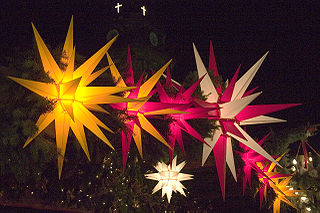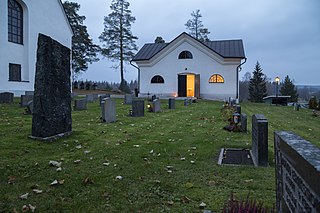
Moravian University is a private university in Bethlehem, Pennsylvania. The institution traces its founding to 1742 by Moravians, descendants of followers of the Bohemian Reformation under John Amos Comenius. Founded as a girls school in 1742, the College itself was founded as the Moravian College and Theological Seminary in 1807 and was accredited in 1863. In 2021, the College was elevated to a University. Moravian University uses the foundation of the Girls school as their foundation date which would make them the sixth-oldest college in the United States.

Herrnhut is an Upper Lusatian town in the Görlitz district in Saxony, Germany, known for the community of the Moravian Church established by Nicolas Ludwig, Count von Zinzendorf, in 1722.

The Moravian Church, or the Moravian Brethren, formally the Unitas Fratrum, is one of the oldest Protestant denominations in Christianity, dating back to the Bohemian Reformation of the 15th century and the Unity of the Brethren founded in the Kingdom of Bohemia, sixty years before Luther's Reformation.

Wachovia was the area settled by Moravians in what is now Forsyth County, North Carolina, United States. Of the six 18th-century Moravian "villages of the Lord" established in Wachovia, today only the town of Bethania and city of Winston-Salem exist within the historic Wachovia Tract. The historical tract was somewhat larger than present-day Winston-Salem and somewhat smaller than present-day Forsyth County.

Old Salem is a historic district of Winston-Salem, North Carolina, United States, which was originally settled by the Moravian community in 1766. It features a living-history museum which interprets the restored Moravian community. The non-profit organization began its work in 1950, although some private residents had restored buildings earlier. As the Old Salem Historic District, it was declared a National Historic Landmark (NHL) in 1966, and expanded fifty years later. The district showcases the culture of the Moravian settlement in the Province of North Carolina during the colonial 18th century and post-statehood 19th century via its communal buildings, churches, houses and shops.

Sunrise service is a worship service specifically on Easter Sunday practiced by some Christian denominations, such as the Moravian Church. The sunrise service takes place outdoors, sometimes in a park, and the attendees are seated on outdoor chairs or benches, or else they stand throughout.
Nazareth Hall (1752–1929) was a school in Nazareth, Pennsylvania. It was built by master mason Melchior Rasp, in 1754, in hopes that Count Nikolaus Ludwig Zinzendorf would return from Europe and settle permanently in the community and send his sons to the school. He never did come back to America, however. It is located in the Nazareth Hall Tract, listed on the National Register of Historic Places in 1980.

A Moravian star is an illuminated decoration used during the Christian liturgical seasons of Advent, Christmas, and Epiphany representing the Star of Bethlehem pointing towards the infant Jesus. The Moravian Church teaches:
...the star reminds us of God, who caused the light to shine out of darkness and of the light which is the life of humanity. It reminds us of the promise of Abraham that his descendants would be more numerous than the stars; we are reminded of the star that pointed to the “great and heavenly light from Bethlehem’s manger shining bright.” The Light shines in the darkness, and the darkness has not overcome it. This is the message of the Advent star, which also points to Jesus, who said, “I am the bright and Morning Star.” It is the star of promise, the star of fulfillment, and the star of hope.

The Moravian musical tradition in United States began with the earliest Moravian settlers in the first half of the 18th century.
These Moravians were members of a well-established church – officially called Unitas Fratrum or Unity of Brethren – that by [the mid-18th century] had already seen almost three centuries of rich experience of religious life. They were spiritual descendants of the Czech priest Jan Hus, who for his attempts at reform was martyred in 1415. Forty-two years later in 1457, some of his followers founded a church body consecrated to following Christ in simplicity and dedicated living.
This newly constituted church developed a rich and orderly ecclesiastical life in the 15th and 16th centuries, but in the Thirty Years War of 1618-48 it was virtually wiped out. In the 1720s a few exiles of this religious heritage, along with various other seekers after truth, found refuge on an estate of a Saxon nobleman named Nicholaus Ludwig von Zinzendorf. There in their village of Herrnhut the ancient church experienced a rebirth culminating in a spiritual blessing on August 13, 1727, in which their former diversity of purpose was welded into one.
In a brief five years, by 1732, that first little village of the Renewed Moravian Church began sending missionaries to all corners of the world. After establishing work in England, the Moravians sent colonists to America in 1735. The initial settlement in Georgia proved unsuccessful, partly because of war between Protestant England and Catholic Spain to the south in Florida. More permanent work was established in Pennsylvania in 1741, with the town of Bethlehem as their chief center. Other settlements in Pennsylvania followed. The Moravians purchased 100,000 acres in North Carolina and settled at Bethabara in 1753 with the central town of Salem being founded in 1766.” [Villages of the Lord]

A dead house, deadhouse or mort house, is a structure used for the temporary storage of a human corpse before burial or transportation, usually located within or near a cemetery. Such edifices were more common before the mid-20th century in areas with cold winter climates, before which time grave excavation during the winter was either difficult or impossible.

The Moravian Church in North America is part of the worldwide Moravian Church Unity. It dates from the arrival of the first Moravian missionaries to the United States in 1735, from their Herrnhut settlement in present-day Saxony, Germany. They came to minister to the scattered German immigrants, to the Native Americans and to enslaved Africans. They founded communities to serve as home bases for these missions. The missionary "messengers" were financially supported by the work of the "laborers" in these settlements. Currently, there are more than 60,000 members.
This article covers the period from the origin of the Moravian Church, as well as the related Hussite Church and Unity of the Brethren, in the early fourteenth century to the beginning of mission work in 1732. Further expanding the article, attention will also be paid to the early Moravian settlement at Bethlehem, Pennsylvania, following their first arrival in Nazareth, Pennsylvania in 1740.

Graceham Moravian Church and Parsonage is a historic church building and parsonage located at 8231 Rocky Ridge Road, MD 77 in Graceham, east of Thurmont, Frederick County, Maryland. It is a two-story Flemish bond brick church built in 1822, and covered with white stucco because of deteriorated masonry. The church was built as an addition to the adjacent meeting house and parsonage built in 1797. This building and the church's cemetery having uniform flat gravestones represents Maryland's only remaining 18th century Moravian settlement.

Fairfield Moravian Church and its surrounding settlement was founded in 1785 in Fairfield, Droylsden, Lancashire, England. It was founded by Benjamin La Trobe as a centre for evangelistic work for the Moravian Church in the Manchester area. Numbers 15, 28 and 30 Fairfield Square are Grade II* listed buildings.

The Indian Tower is a lookout tower that sits at the highest point of the original 5,000 acres (20 km2) of Nazareth, Pennsylvania.

John Christian Bechler was a Moravian bishop, composer, and organist.
Charles Gotthold Reichel was a Moravian bishop.
Melchior Rasp was an Austrian master mason. He built several notable buildings in the Moravian community in today's Old Salem, North Carolina. These buildings are some of the few that have survived.
Gottfried Aust was a German master potter. He was the first master potter in the Moravian community in today's Old Salem, North Carolina.

God's Acre Cemetery is a cemetery for the Moravian congregation in Old Salem, North Carolina. It is located around 100 yards (91 m) north of the town's Home Moravian Church and also serves the thirteen member churches of Salem's congregation: Ardmore, Bethesda, Calvary, Christ, Fairview, Fires, Home, Immanuel New Eden, Konnoak Hills, Messiah, Pine Chapel, St Philips and Trinity. St Philips has a second cemetery in the northeastern corner of the adjacent Salem Cemetery.

















